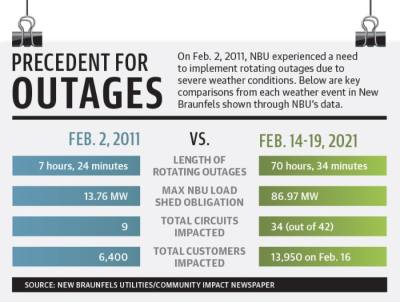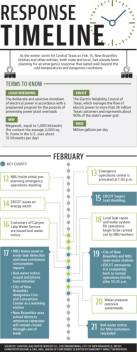The havoc caused by the severe weather locally led to school and business closures, mass power outages, undriveable roads and loss of running water that resulted in boil water notices.
Ben Sanchez, co-owner of New Braunfels CBD shop Go Green Botanicals, said he had to close his business for five days.
“We did lose about 98% of our revenue [that week], though we had a few online orders, and our customers understood,” Sanchez said. “Once we got back in though, which was Friday [Feb. 19], we were hustling and bustling.”
The cold snap arrived late Feb. 14, and by Feb. 16, much of the state was entering a second day of power outages.“What that caused was unprecedented events and impacts to the statewide electric grid, to NBU’s electric system and also to our water system,” said Ian Taylor, chief executive officer of New Braunfels Utilities, on Feb. 23. NBU, which has 47,162 active electric customers, had to cut power for the highest amount of people on Feb. 16, when at one point 13,950 customers, or about 30%, experienced rotating outages.
By NBU’s initial estimates, its cost to generate power for the month of February was about $82 million—$6.5 million shy of the company’s total power generation and transmission budget of $88.5 million for the fiscal year.
While no specifics have yet been divulged, New Braunfels City Manager Robert Camareno said figuring out how to better respond to future emergencies remains a top priority for local officials.
“We’ll be doing an after-action review to determine ... what opportunities are there for us to be able to enhance our response and our preparedness for events such as the latest winter weather that we experienced,” Camareno said.
Explaining the outages
The state’s power grid, called the Electric Reliability Council of Texas, or ERCOT, accounts for 90% of the power load in Texas, minus areas including El Paso, the Panhandle and parts of East Texas.
Taylor said a failure on the part of ERCOT to winterize the state’s coal, natural gas, nuclear, solar and wind infrastructure led to insufficient power generation across the state’s fleet of generators, which caused them to shut off.
Taylor added that ERCOT had to undergo a process called load shedding, which involves the deliberate shutdown of electric power in a part or many parts of its system. Power providers must undergo this process when their energy load exceeds their generation output, and if the power imbalance is not properly handled through load shedding, then suppliers could end up with catastrophic outages that could take weeks, even months to rectify, he said.
NBU already had plans in place for load shedding during extreme circumstances, but Taylor said February’s extended severe cold temperatures required a much larger load shed effort than NBU has had to accommodate in the past. “When this event first started ... they just kept telling us to shed more and more and more and more,” Taylor said. “It was something like we had never seen before.”
Furthermore, once the temperatures rose above freezing, plumbing failed in many residences and businesses, causing leaks and breaks throughout NBU’s coverage area.“The leaks were so bad it literally drained our system,” Taylor said. “We had our pumps running 24/7 at maximum capacity, and they weren’t keeping up. So, when it came time to refill the system, it took a bit of time.”
An investment in infrastructure
Though the February storm caused still uncalculated damage across the New Braunfels area, Taylor said numerous infrastructure investments made by NBU in the last four years helped tamp down what could have been a much more catastrophic event.
As one example, Taylor said that in 2016 NBU’s maximum pumping capacity maxed out at about 21 million gallons per day, or MGD, but due to upgrades made by the utilities company, the pumping capacity was up to 28 MGD during the mid-February severe weather.
Had some facilities not been offline during the weather event, that capacity would have been up to 34 MGD.NBU’s electric system has also benefited from recent overhauls, and Taylor said that had the utilities company not been adding equipment to help distribute power, the outages would have been much longer.
Initial figures from NBU show that the impacts in mid-February were not only substantial, but dwarf the other most significant NBU power interruption from a decade ago.
On Feb. 2, 2011, severe weather resulted in NBU implementing rotating power outages for a total of seven hours and 24 minutes. During the 2021 weather event, rotating outages lasted a total of 70 hours and 35 minutes, exceeding the 2011 outages by a factor of 10.
During the Feb. 23 City Council meeting, Taylor emphasized the difference those investments made.
“I want to thank you for your support of the investments and infrastructure that you’ve enabled over the last four years and that we’re continuing to do to be able to keep up with growth,” he said.
A communitywide effort
After NBU began implementing rotating power outages that would last through Feb. 17, boil water notices were sent out to residents throughout the area, including for customers of NBU and the Canyon Lake Water Service Co.
Both New Braunfels ISD and Comal ISD had to cancel classes through Feb. 23.During the height of the outages, city leaders established a warming center at the New Braunfels Civic Center, which also served as a water station where residents experiencing water loss or plumbing issues could fill large containers with purified water.Camareno said there were many calls to the police and fire departments, and public works crews worked around the clock to make roads negotiable when possible.Numerous volunteers and city staff members helped with the creation and operation of the warming center and water station, he said.
“I was really proud of how we worked so closely with NBU and their staff to be able to do all of those things together,” he said.
Included in the communitywide effort to diminish the impact of the storm were water and food donations from a number of organizations, including the New Braunfels Food Bank, The Wurstfest Association, BCSF Health and Human Services, the New Braunfels Chamber of Commerce, Chick-fil-A and Dairy Queen.“I am certainly grateful to all of those [entities],” he said.
Assessing what can be done
At the Feb. 23 New Braunfels City Council meeting, Council Member James Blakey said that while he praises the effort put forth by city staff and NBU crews to mitigate in real time the damage caused by the weather, there are some lessons that can be learned.“We need to get people signed up for alerts. I had people who said, ‘Well, I didn’t know we had to boil water,’” Blakey said, adding that officials must urge residents to contact the city and NBU, among other entities, to sign up for emergency notification lists.
Camareno said plans are underway to conduct an after-action review, whereby city staff will conduct a comprehensive analysis.
There is not yet an established time frame for when staff will return to City Council with its determinations and recommendations from the after-action review, and Camareno said it could be anywhere from weeks to a couple of months.
Energy bills and other expenses have also been a source of major concern for residents, and NBU and the city have set in motion plans to defray costs.On Feb. 22, the city of New Braunfels announced a program to help lower costs for repairs needed as a result of the storm.
Specifically, residents applying for plumbing permits or permits for work associated with water or weather damage were asked to apply with the city to have fees waived. Additionally, the city began prioritizing and expediting the review of plumbing permits, inspections and plumbing contractor registrations for storm repairs.“I know that plumbers are extremely busy right now trying to address as many of those issues as possible,” Camareno said.
NBU has also set in motion plans to alleviate customer concerns over perceived skyrocketing utility bills.A Feb. 21 news release from the company states it has experienced sharp increases in the cost of fuel, but the company is pursuing every financing tool within its ability to spread the financial impact over years, including spreading out costs to increase customer affordability.
Many other plans are still in the works, and Taylor said it will likely be several weeks before NBU can provide more specific details on the financial impact of the storm to its customers.
With regard to other initiatives, NBU Chief Operations Officer Ryan Kelso said several departments are working on their own after-action reports, which will soon converge into a collective plan for the entire company.“We also plan to involve members of the City Council, members of the NBU board and members of the community to give some input as to what went right, what went wrong and where they really want us to focus on areas of improvement,” Kelso said. “This event really did have a large impact on members of the community.”








